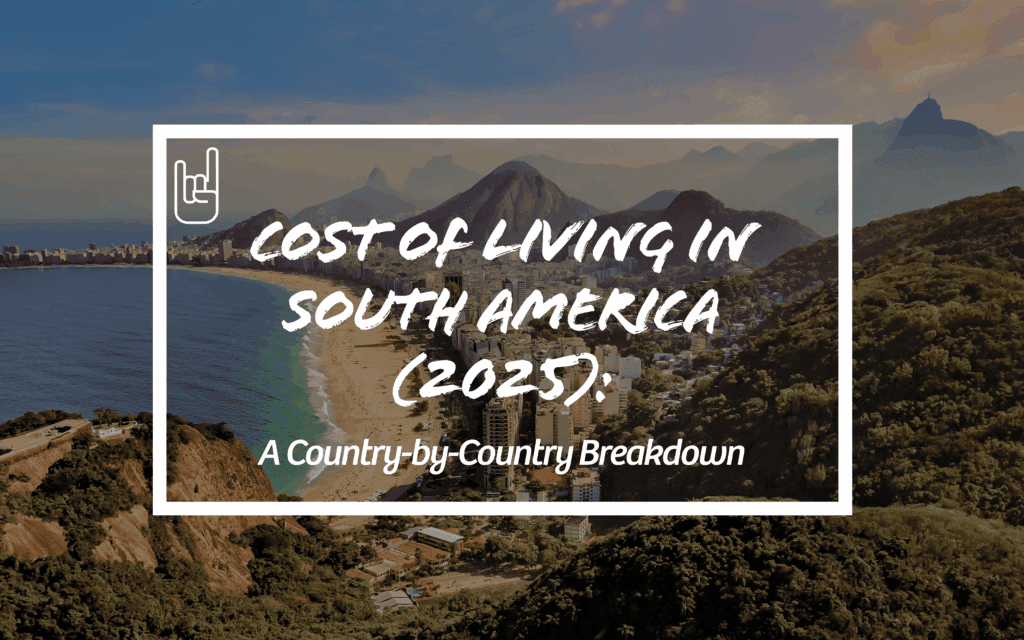Cost of Living in South America (2025):
A Country-by-Country Breakdown for Long-Term Travelers & Digital Nomads
Wondering if South America is still an affordable region to live or travel in 2025?
Updated October 2025 (from Lima, Peru). Figures below use 2025 cost-of-living datasets for comparability. Sections labeled From our time in Ecuador and Peru reflect our lived costs and on-the-ground notes; other country sections are data summaries for planning based on Numbeo data.
Cost of Living in South America (Quick Guide)
💳 Money: Avoid ATM fees with Wise or Revolut.
🏠 Stay: Booking.com & Airbnb often have long-stay discounts. TrustedHousesitters if you’re flexible.
🚐 Transport: Buses are cheap, rentals faster, compare with DiscoverCars.
📱 Data: Buy an Airalo eSIM before you fly.
🛡️ Insurance Lightweight family insurance coverage
🍎 Food: $3–$5 street food, $8–$15 restaurants, markets are cheapest.
Why We Built This Guide
Dreaming of a family gap year in South America, but unsure what it’ll actually cost to live, eat, and exist day to day?
You’re not alone, we were in the same boat. Whether you’re plotting a 6-month escape, going remote, or prepping to slow-travel as a family, knowing the real cost of living is what turns daydreams into departure plans.
This guide breaks it all down country by country, using current 2025 data from Numbeo (the world’s largest user-powered cost-of-living database), plus a family travel lens based on our own long-term prep.
No fluff. Just the real numbers behind rent, food, transport, and daily life across twelve South American countries, so you can plan with confidence, not guesswork.
Table of Contents
How This Data Was Collected
Methods & Sources (2025): We compiled 2025 cost-of-living figures (rent, groceries, restaurants, utilities, transit) from large public datasets (e.g., Numbeo) and converted to USD for easy comparison. For Ecuador, we add lived notes from our current stay to show how “the numbers” feel day-to-day for a family of four. Your actual spend will vary by city, neighbourhood, pace, and season.
Monthly rent (1–3 bedroom apartments, city center vs suburbs)
Groceries and everyday food costs
Transportation (public transit passes, fuel)
Restaurants (budget vs mid-range)
Utilities and Wi-Fi
All prices are converted to USD for comparison, and we’ve included two snapshots per country:
Solo traveller estimate
Family of four estimate
You’ll also find callouts where costs differ drastically by city (e.g. Quito vs Cuenca, or Buenos Aires vs Mendoza), and notes where we’ve layered in family-relevant insight, like where you’ll find parks, fast Wi-Fi, Best eSIM data plan or cheap playground-side empanadas.
This blog is fuelled by caffeine and chaos, if it helps, support our journey.
Cost of living by country South America Comparison (2025)
Here’s a quick, bullet-style comparison across the twelve countries we analysed. This is a starting point, deeper breakdowns follow in the next sections.
🇧🇴 Bolivia
One of the most affordable countries in South America
1-bed rent in La Paz: ~$250/month
Local lunch: $2–3
Monthly budget (solo): ~$700 / (family of 4): ~$1,300
🇪🇨 Ecuador
Solid balance of low cost and infrastructure
2-bed apartment outside Quito: ~$450/month
Groceries: ~$250/month (solo)
Monthly budget (solo): ~$1,000 / (family): ~$1,800
🇨🇴 Colombia
Fast-growing nomad hotspot (especially Medellín)
Rent (city center): ~$500–600/month
Menu del día: ~$3
Monthly budget (solo): ~$1,000 / (family): ~$1,700
🇵🇪 Peru
Affordable, especially outside Lima
Groceries for 1: ~$220/month
Inexpensive restaurants: $3–5
Monthly budget (solo): ~$950 / (family): ~$1,700
🇦🇷 Argentina
Wild inflation = variable cost
Rent is still low: ~$300–500/month
Local meal: $4–6
Monthly budget (solo): ~$1,100 / (family): ~$1,900
🇨🇱 Chile
Most expensive of the bunch
Rent (Santiago): $600–800/month
Grocery prices closer to Europe
Monthly budget (solo): ~$1,400 / (family): ~$2,400
🇺🇾 Uruguay
Quiet, stable, but pricey
Rent in Montevideo: ~$700+
Great digital infrastructure
Monthly budget (solo): ~$1,500 / (family): ~$2,500
🇵🇾 Paraguay
Low cost, often overlooked
2-bed rent: ~$350
Public transport: ~$0.40
Monthly budget (solo): ~$800 / (family): ~$1,400
🇧🇷 Brazil
Big price range depending on region
1-bed rent in São Paulo: ~$420/month
Local meal: ~$6
Monthly budget (solo): ~$1,200 / (family of 4): ~$2,100
🇻🇪 Venezuela
Extremely low cost, but safety risks remain
1-bed rent in Caracas: ~$200/month
Local meal: ~$2.50
Monthly budget (solo): ~$700 / (family): ~$1,200
🇬🇾 Guyana
Caribbean-South America hybrid — rugged and affordable
1-bed in Georgetown: ~$350/month
Cheap restaurant meal: ~$4
Monthly budget (solo): ~$950 / (family): ~$1,600
🇸🇷 Suriname
Dutch-Caribbean charm with low costs
1-bed in Paramaribo: ~$340/month
Local meal: ~$4.50
Monthly budget (solo): ~$900 / (family): ~$1,600
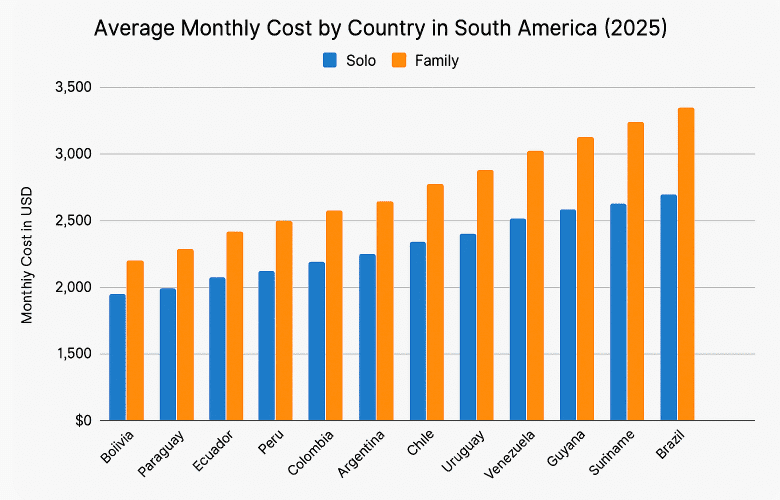
How much does it cost to live in South America 2025?
Now let’s zoom in. We’ll unpack each country with real price samples, notes on family-friendliness, and where you’ll get the most value for your budget.
🇦🇷 Argentina: Budget-Friendly Adventure With a Side of Instability

If you’re looking for great value and big personality, Argentina delivers as long as you’re prepared for financial curveballs. With a long history of economic volatility and inflation, the country’s cost of living can fluctuate from month to month. But for budget-conscious travellers (and families), this can work in your favour… Argentina offers high quality of life at a low cost, particularly if you’re bringing in foreign currency.
Estimated Monthly Cost (2025)
Solo traveler: ~$1,100 USD
Family of four: ~$1,900 USD
Housing
1-bed city centre (Buenos Aires): ~$330
3-bed outside city centre: ~$535
Outside major cities, rent drops further. Places like Mendoza or Salta offer relaxed lifestyles, walkable centres, and scenic backdrops for far less than Europe or North America.
Food & Groceries
Groceries (family): ~$350
Local meal (inexpensive restaurant): $5
Argentina is meat-heavy (empanadas, choripán, and of course, steak), but local markets are budget-friendly even for vegetarians. Cook at home to keep costs down, or eat where locals eat, menu del día-style cafes are everywhere.

Transport
- Monthly public transport pass (Buenos Aires): ~$11
Subway and bus systems in cities are cheap and extensive. Intercity buses are affordable, comfortable, and family-friendly a big plus for long-term travel without renting a car.
Family Travel Insight
Argentina loves kids. Expect free entry for children at many parks and attractions, and you’ll rarely get side-eyes bringing toddlers to a restaurant. Buenos Aires is a vibrant, stroller-friendly city (with surprisingly good playgrounds), and smaller towns like Bariloche or El Calafate offer a taste of Patagonian adventure with less chaos.
Final Thought
Argentina’s economic unpredictability might make budget planning tricky, but if you’re willing to be flexible, it’s one of the best value-for-money destinations on the continent and a deeply cultural, scenic one at that.
🇧🇴 Bolivia: Raw, Rugged, and Incredibly Affordable
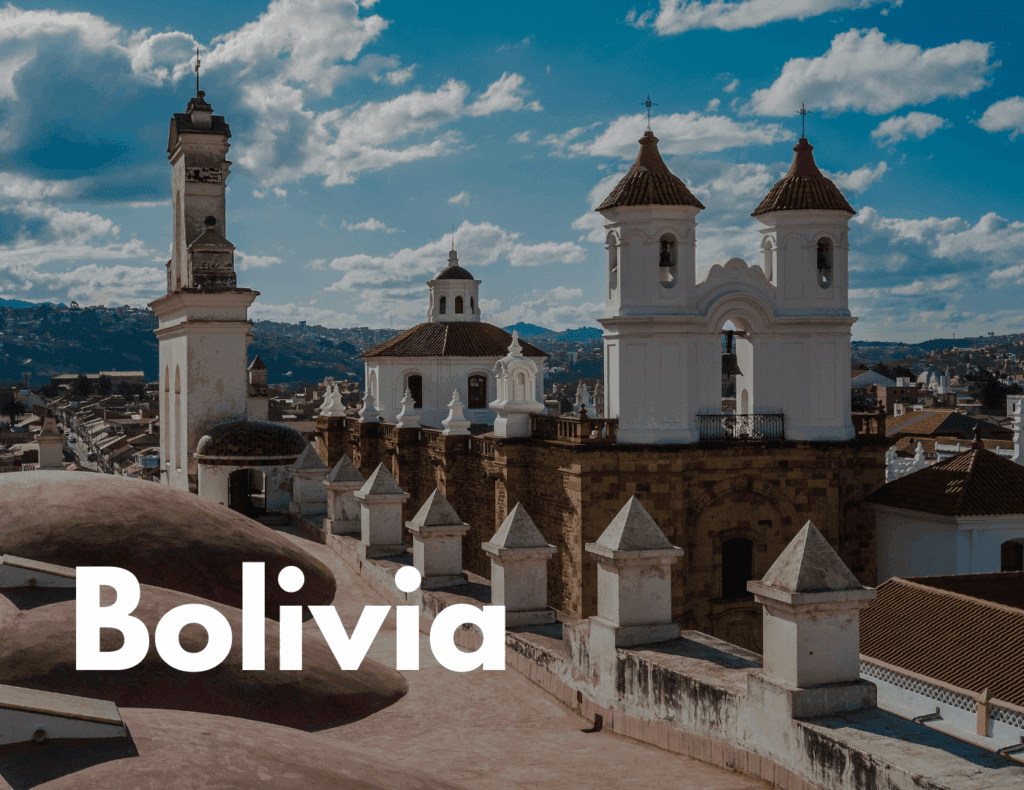
Bolivia is South America’s true budget stronghold. It’s also one of its most rugged, less infrastructure, fewer creature comforts, but enormous cultural and natural payoff. This is a destination where the adventurous can live well for under $40 a day and where a family can travel for less than the cost of rent back home.
Estimated Monthly Cost (2025)
Solo traveler: ~$700 USD
Family of four: ~$1,300 USD
Housing
1-bed in La Paz: ~$260
3-bed outside city centre: ~$370
Even in the capital, rent is incredibly low. Many digital nomads and travelers base themselves in Sucre, a calmer, cheaper colonial city with decent Wi-Fi and short walking distances.
Food & Groceries
Groceries (family): ~$280
Local meal: $2.50
Markets are king here. Fresh produce is cheap and abundant. Eating out can be cheaper than cooking, think rice, lentils, grilled meat, and heaps of potatoes for under $3 per plate.
Transport
- Monthly public transport pass: ~$8
Microbuses, taxis, and colectivos dominate the urban transport scene. Long-distance travel is cheap but often slow, a tradeoff for the low cost.
Family Travel Insight
Bolivia isn’t the most kid-friendly in terms of infrastructure (think: uneven streets, minimal changing tables), but it offers incredible cultural experiences for older kids, salt flats, llamas, and mountains that make the iPad feel irrelevant. Sucre and Cochabamba are better picks for slower, family-oriented travel than bustling La Paz.
Final Thought
If you want true off-the-beaten-path travel on a tight budget, Bolivia is unmatched. It’s not always smooth, but the experience is unforgettable and for families on a long-term journey, that’s part of the point.
🇧🇷 Brazil: Big Cities, Bigger Costs But Incredible Diversity

Brazil offers a vibrant blend of beach life, jungle exploration, and city energy, but it’s not the cheapest stop on the map. While places like São Paulo and Rio de Janeiro carry a high cost of living by South American standards, Brazil rewards slow travellers who head inland or explore lesser-known regions.
Estimated Monthly Cost (2025)
Solo traveler: ~$1,200 USD
Family of four: ~$2,100 USD
Housing
1-bed in São Paulo (city centre): ~$420
3-bed outside centre: ~$700
Rio is typically more expensive than São Paulo, especially closer to the beach. However, if you base yourself in places like Florianópolis, Salvador, or even Minas Gerais, rent drops significantly often by 30–40%.
Food & Groceries
Groceries (family): ~$420
Local meal: $6
Food in Brazil is rich and varied. You can find cheap eats like pão de queijo, street feijoada, or pastel for under $3. Cooking at home can be economical, but beware supermarkets can get pricey if you’re not sourcing locally or seasonally.
Transport
- Monthly public transport pass (São Paulo): ~$50
Buses and metro systems are efficient in major cities, but rideshare apps are often more reliable in smaller towns. Brazil’s intercity buses are modern but not cheap, slow travel helps you save.
Family Travel Insight
Brazil is child-friendly, families are treated with warmth in most public places, and it’s common to see kids out late in restaurants. That said, safety is region-dependent. Avoid favelas, stay in well-rated areas, and prioritise daytime exploration. Wi-Fi is solid in cities but patchy in remote areas.
Final Thought
Brazil offers a ton of value but it requires smart planning and regional savvy. For families, it’s not the cheapest destination, but it’s rich in culture, nature, and rhythm. Think of it as a high-reward middle-tier cost country on the South America map.
🇨🇱 Chile: The Price of Comfort

Chile consistently ranks as one of the most expensive countries in South America, but that comes with perks: stable infrastructure, excellent safety, and a modern feel that’s more Western Europe than backpacker frontier. If you’re seeking reliability over rustic charm, Chile might be your pick.
Estimated Monthly Cost (2025)
Solo traveler: ~$1,400 USD
Family of four: ~$2,400 USD
Housing
1-bed in Santiago (city centre): ~$590
3-bed outside city centre: ~$800
Smaller cities like Valparaíso or La Serena offer more budget-friendly living with a similar quality of life, great options for digital nomads or families who want a slower pace.
Food & Groceries
Groceries (family): ~$500
Inexpensive restaurant meal: ~$9
Dining out adds up fast in Chile. While the food is good, cooking at home can save you hundreds monthly. Supermarkets feel more European in price, you won’t find $2 lunches here.

Transport
- Public transport pass: ~$45/month
Efficient metros in Santiago, plus modern intercity buses and widely available rideshare apps make getting around safe and easy, even with kids in tow.
Family Travel Insight
Chile is one of the safest and most well-organised countries on the continent. Public spaces are clean, streets are walkable, and healthcare is among the best in South America. This makes it especially appealing to families looking for stability, albeit at a cost.
Final Thought
If budget is your primary concern, Chile might not make the shortlist. But if you value ease, comfort, and a strong infrastructure for both work and parenting, it’s a worthy contender especially for longer stays in smaller cities.
🇨🇴 Colombia: Affordable, Connected, and Full of Surprises

Colombia has exploded in popularity with digital nomads and budget travellers over the past five years and for good reason. It offers a winning combo of low cost of living, strong infrastructure in major cities, and a surprisingly family-friendly culture. While its past reputation still lingers, modern Colombia is open, energetic, and affordable.
Estimated Monthly Cost (2025)
Solo traveler: ~$1,000 USD
Family of four: ~$1,700 USD
Housing
1-bed apartment in Medellín (city centre): ~$410
3-bed outside city centre: ~$600
Medellín is the nomad hotspot, but Cali, Bucaramanga, and Santa Marta offer lower rents with growing remote work infrastructure. Even Cartagena, though touristy it has affordable options just outside the city core.
Food & Groceries
Groceries (family): ~$310
Local meal: ~$3.50
Colombian markets are unbeatable for fresh produce and local staples. Lunch deals (“menu del día”) typically include soup, a main, drink, and sometimes dessert all for under $4. Western-style supermarkets are more expensive, but still affordable.
Transport
- Monthly public transport pass (Medellín): ~$25
Medellín’s metro system is safe, efficient, and clean a rarity in Latin America. Buses are widespread but slower. Intercity travel is affordable but long (due to terrain), so internal flights are common and relatively cheap.
Family Travel Insight
Colombia is surprisingly accommodating for families. People are warm toward kids, and it’s common to find family-oriented activities in public parks, plazas, and museums. Medellín’s cable cars offer both a transportation perk and an exciting outing for little ones.
Final Thought
Colombia balances adventure and practicality. For digital nomads, it checks all the boxes: low rent, good Wi-Fi, vibrant coworking. For families, it offers value and culture, just stay up to date on local safety advice and neighborhood recommendations.
🇪🇨 Ecuador: Quiet Confidence and Dollar-Based Simplicity
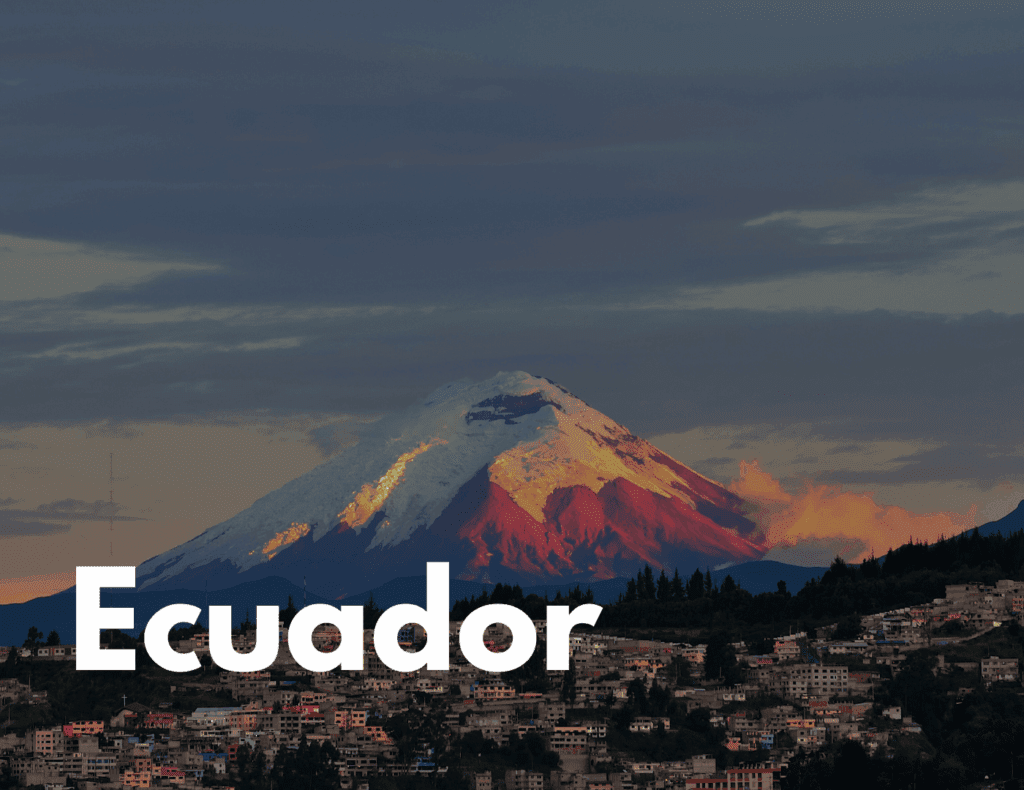
Ecuador often flies under the radar, but for families or nomads looking for balance, it’s a fantastic choice. It’s safe, slow-paced, and uses the US dollar, which means no wild currency swings and a bit more financial predictability. While not the cheapest country on the continent, its value is high, especially outside the capital and cost of living in Ecuador is still very cheap.
From our time in Ecuador (lived notes):
Groceries vs. eating out: Local markets keep fruit/veg cheap; “almuerzo” set lunches (soup + main + juice) make eating out 2–3×/week realistic without blowing the budget.
Transit: City buses are very low-cost; with kids we lean on ride-hail/taxis for convenience—still affordable for cross-town trips.
Altitude tax: In Quito, early nights + extra water/electrolytes are real. We spent a bit more the first week on quick meals and ride-hails while we adjusted.
Data: Airalo eSIM worked on arrival; we added a local SIM after a week for cheaper top-ups.
City snapshots (typical ranges we observed + dataset guidance):
- Quito (capital, altitude): More choice; slightly higher rents. Long-stay 2–3 bed outside center can be very reasonable with monthly deals.
- Cuenca (expat favorite): Often cheaper than Quito; super walkable, parks/playgrounds galore—good for families and worldschooling rhythm.
- Coast (Manta/Salinas): Seasonal swings; utilities (A/C) can bump bills. Slower pace, simpler budgets.
Family tip: We target 28–30-night stays and politely message 5–10 hosts—monthly discounts of 15–40% are common for clean, well-reviewed apartments.
Estimated Monthly Cost (2025)
Solo traveler: ~$1,000 USD
Family of four: ~$1,800 USD
Housing
1-bed in Quito (city centre): ~$330
3-bed outside city centre: ~$510
Cities like Cuenca or Loja are even cheaper and are growing in popularity with expats. For long-term travel, these smaller hubs offer a great cost-of-living-to-comfort ratio.
Food & Groceries
Groceries (family): ~$320
Local restaurant meal: ~$3.50
Local almuerzos (set lunches) are widespread and often include soup, rice, meat or eggs, and juice. Eating out a few times a week doesn’t wreck the budget, especially in smaller cities.
Transport
- Public transport pass: ~$16/month
Buses are dirt cheap ($0.25–0.50 per ride), and taxis or rideshare apps are widely used. Internal flights are available but not always budget-friendly, plan land travel with extra time in mind.
Family Travel Insight
Ecuador is calm. Families will appreciate the slower pace, less traffic stress, and friendly public vibe. Cuenca is especially appealing for worldschoolers, walkable, safe, and culturally rich with lots of green space.
Final Thought
Ecuador won’t wow you with buzz or glitz but that’s kind of the point. It’s a stable, wallet-friendly, and comfortable place to base yourself for a month or six. For families, that consistency is a hidden gem.
🇵🇾 Paraguay: The Hidden Gem for Long-Term Budget Travelers

Paraguay is rarely at the top of a South America itinerary and that’s exactly what makes it appealing. It’s one of the cheapest countries on the continent, and while it lacks major tourist infrastructure, it offers a peaceful, authentic lifestyle that can be ideal for budget-conscious travelers or slow-traveling families who want a break from the typical “gringo trail.”
Estimated Monthly Cost (2025)
Solo traveler: ~$800 USD
Family of four: ~$1,400 USD
Housing
1-bed in Asunción (city centre): ~$320
3-bed outside city centre: ~$480
Rent is low across the country, and even in the capital, long-term rentals are surprisingly affordable. For those staying longer than a few months, it’s possible to find unfurnished homes in quiet suburbs at even lower rates.
Food & Groceries
Groceries (family): ~$300
Local restaurant meal: ~$3.50
Food is hearty and heavily meat-based, but local produce is cheap and widely available. While restaurant variety is limited outside Asunción, the cost of both eating out and cooking is very low compared to neighbouring countries.

Transport
- Public transport pass: ~$20/month
Buses are the main form of local transport and cost as little as $0.40 per ride. The intercity system isn’t as developed as elsewhere in South America, but traffic is light and rides are manageable.
Family Travel Insight
Paraguay offers a calm environment with minimal tourist traffic, making it a good pick for families wanting to lay low and stretch their budget. That said, it’s better suited for older kids or teens there’s less to “do” for toddlers, and infrastructure like playgrounds, changing stations, or modern medical care can be limited in smaller towns.
Final Thought
If you’re looking for low-cost living, fewer crowds, and a break from the backpacker buzz, Paraguay delivers. It’s not flashy, but for families or nomads wanting an affordable, off-grid chapter, it’s a strong contender.
Family Travel Kickstart Kit
6 Products. One kit. Lifetime access
🇵🇪 Peru: Big Destinations, Small Budget
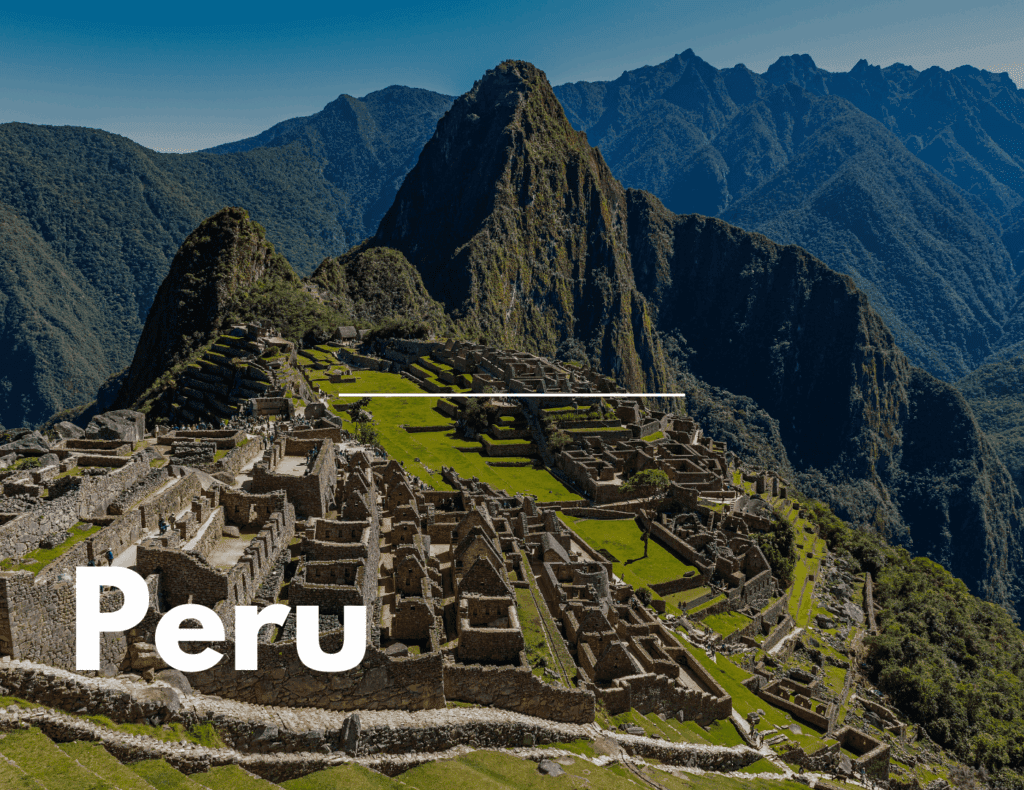
After criss-crossing Peru with the kids, here’s the honest picture: Peru is still high-reward and (mostly) affordable, but prices shift more than we expected outside the big hubs. We also saw clear wins using Uber over street taxis, and we’re now firmly in the night-bus > day-bus camp for long routes with kids. Peru is also incredibly affordable for travellers.
What Peru actually cost us
Monthly ballpark: Solo $950–$1,150 • Family of four $1,700–$2,100 (higher if you move often or stay in remote towns with little competition).
Housing: Numbeo data says Lima 1-bed $350–$500; 3-bed outside centre $520–$750. This is if you live here, if you travel and wan’t some form of quality then expect to pay around $30-50 a day. Cusco/Arequipa generally cheaper, but plan a gentle first week in Cusco (3,400 m).
Food: Groceries for a family $320–$400/mo if cooking. Menu del día S/10–18 ($2.70–$4.80) pp in cities. Our best bargain was in Ica: S/36 (~$10) for all four (veg set lunch).
Activities we paid: Huacachina sandboarding S/220 (~$65) for ~2–3 hrs (booked via our Airbnb; kid-friendly body-boarding style).
Transport lessons (that saved sanity)
City rides: Where Uber/Cabify run, they’re consistently cheaper and calmer. In Ica, street taxis quoted ~2× Uber for the same route. Data on your phone = fewer arguments.
Long-distance: Buses are comfortable, but our Lima→Ica day bus crawled with traffic and random stops. With kids, night buses (semi-cama/cama) were simply better: you sleep through delays and arrive functional.
Regional quirks: In the far north / isolated areas, expect higher fares (fewer operators) and looser schedules. Build buffer hours into move days.
Food & Groceries
Groceries (family): ~$320
Local meal: ~$3.50–5
Peru has one of the most vibrant culinary scenes on the continent. Even modest restaurants serve incredible local dishes like lomo saltado, ceviche, or ají de gallina, often at backpacker-friendly prices.
Where prices crept up
Northern/coastal or isolated towns with limited inventory (rooms, tours, transport) priced higher than Lima/Cusco equivalents.
Food near headline sights costs more; step a few blocks back for normal menus.
Family notes we'd tell a friend
Peru is still a great entry-level adventure: markets, ruins, dunes, wildlife, and workable infrastructure.
Go slow at altitude (48–72 hrs easy days), and let menu del día do the heavy lifting on budget and moods.
For a slam-dunk day: Huacachina sandboarding at sunset—safe, thrilling, and worth the sand in your shoes.
Final Thought
Peru remains a sweet spot—low to fair costs, big experiences, as long as you plan for regional price bumps up north/remote, use Uber over taxis when possible, and give yourselves buffer time on travel days. Keep the pace realistic, and Peru keeps giving.
🇺🇾 Uruguay: Quiet, Stable — But Not Cheap
Uruguay is one of the most peaceful, developed, and progressive countries in South America, and it shows in the price tag. With a strong middle class and high quality of life, costs here can rival Southern Europe. For families or digital nomads looking for a relaxed pace with modern infrastructure, it’s a solid (if pricey) choice.

Estimated Monthly Cost (2025)
Solo traveler: ~$1,500 USD
Family of four: ~$2,500 USD
Housing
1-bed in Montevideo (city centre): ~$610
3-bed outside city centre: ~$880
Montevideo and coastal towns like Punta del Este offer modern amenities, but rent is high across the board. For long-term stays, look for suburban or off-season rentals.
Food & Groceries
Groceries (family): ~$500
Inexpensive meal out: ~$10
Uruguay’s dining scene is meat-forward and relatively expensive. Cooking at home helps, but groceries (especially imported goods) can be costly.

Transport
- Public transport pass: ~$45/month
Montevideo has a clean and reliable bus network, and local travel is safe and simple. Intercity buses are modern, but not cheap, slow travel wins here.
Family Travel Insight
Uruguay ranks high on safety, cleanliness, and healthcare. It’s one of the most LGBTQ+ and family-inclusive countries in South America. Montevideo has playgrounds, long beach promenades, and peaceful neighbourhoods, great for kids.
Final Thought
If you have the budget and crave stability, Uruguay is a fantastic base. It’s not the cheapest, but it may offer the most relaxed, Western-feeling lifestyle on the continent.
🇻🇪 Venezuela: Caution Required, But Costs Are Low
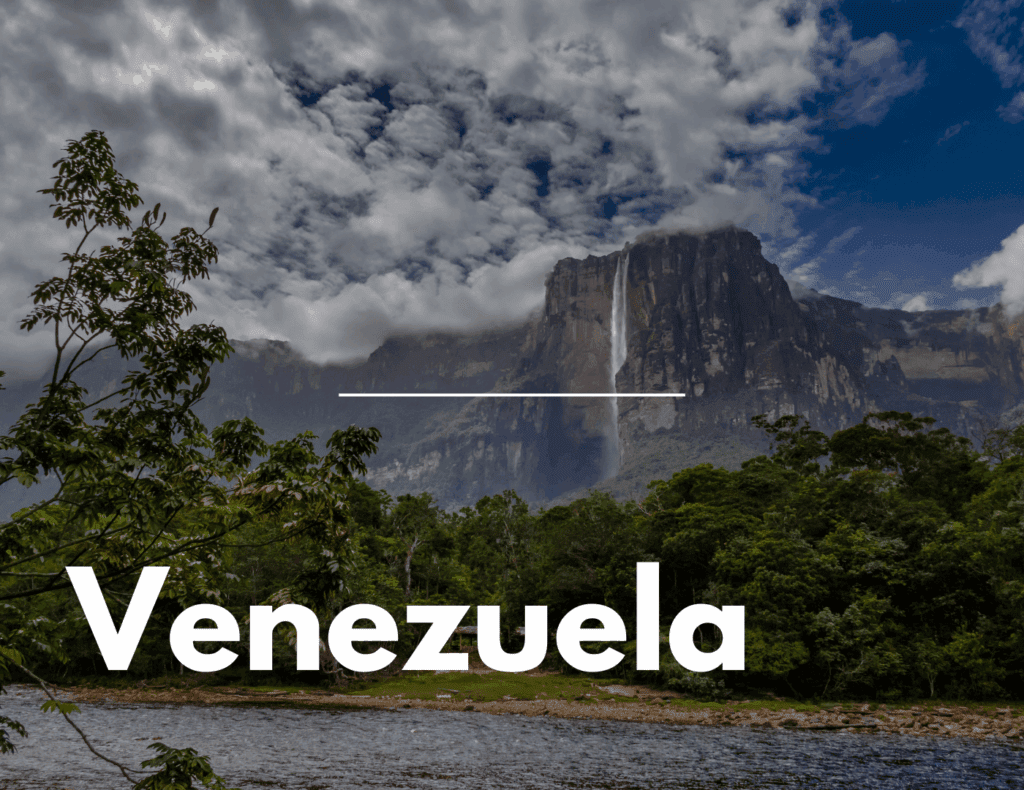
Once a top South American destination, Venezuela’s ongoing political and economic crisis has drastically reduced its tourism infrastructure. That said, it’s still home to stunning landscapes and one of the lowest costs of living anywhere, but travellers must proceed with extreme care and do current research.
Estimated Monthly Cost (2025)
Solo traveler: ~$700 USD
Family of four: ~$1,200 USD
Housing
1-bed in Caracas: ~$200
3-bed outside city centre: ~$300
Housing is extremely affordable, but options are often limited in quality or availability due to inflation and supply issues.
Food & Groceries
Groceries (family): ~$250
Meal out: ~$2.50
Food is cheap, but availability can vary. Stick to local produce and market staples to stretch your budget.
Transport
- Public transport: ~$4/month (subsidized)
Gas is virtually free, but the transport system is unreliable and often unsafe. Private drivers or internal flights may be safer for families, though pricier.
Family Travel Insight
Venezuela is not ideal for families right now. Safety concerns, limited medical infrastructure, and unpredictable conditions mean you’ll need trusted local support and up-to-date advice if traveling with kids.
Final Thought
Venezuela offers incredibly low costs and unmatched natural beauty, but unless you have deep ties or extensive experience in Latin America, it’s better approached with caution or avoided for now.
🇬🇾 Guyana: Jungle Vibes on a Shoestring

Guyana is a different flavour of South America English-speaking, Caribbean-influenced, and largely underdeveloped. It’s rugged, remote, and great for eco-tourists or families craving off-the-beaten-path adventure.
Estimated Monthly Cost (2025)
Solo traveler: ~$950 USD
Family of four: ~$1,600 USD
Housing
1-bed in Georgetown: ~$350
3-bed outside city centre: ~$550
Outside of Georgetown, housing is sparse but cheap. Most rentals are basic, and infrastructure may be lacking, so come prepared.
Food & Groceries
- Groceries (family): ~$300
Cheap restaurant meal: ~$4
Markets are affordable and full of Caribbean flavors. Fresh fish, rice, root veg, and tropical fruit dominate. Imported goods, however, can be pricey.
Transport
- Public transport: ~$20/month
Buses and minibuses are cheap but informal. Roads are rough outside cities. Domestic flights and river transport are often necessary.
Family Travel Insight
This is a destination for outdoorsy, flexible families. Jungle treks, waterfalls, and wildlife are everywhere, but modern comforts are few. It’s not stroller-friendly, but older kids will thrive on the adventure.
Final Thought
Guyana is one of South America’s best-kept secrets and still wildly affordable. It’s not polished, but that’s part of the draw.
🇸🇷 Suriname: Small Country, Big Contrast

Suriname blends Dutch colonial history, Afro-Caribbean culture, and Amazonian jungle all on a small budget. It’s often overlooked, but it can offer a unique, peaceful base for travelers seeking cultural depth and low costs.
Estimated Monthly Cost (2025)
Solo traveler: ~$900 USD
Family of four: ~$1,600 USD
Housing
1-bed in Paramaribo: ~$340
3-bed outside centre: ~$520
Housing is inexpensive, especially outside the capital. Options range from colonial-era flats to simple jungle bungalows.
Food & Groceries
Groceries (family): ~$320
Local restaurant meal: ~$4.50
Food is diverse, think Indian, Indonesian, Dutch and relatively affordable. Local ingredients are cheap, while imported ones inflate the bill.
Transport
- Public transport pass: ~$20/month
Mini-buses and taxis are standard, but infrastructure is basic. Roads outside Paramaribo can be inconsistent, and self-driving is tricky.
Family Travel Insight
Suriname’s pace is slow, people are friendly, and the capital is walkable. While modern services are limited, the cultural and nature-based experiences can be memorable for older kids, especially those worldschooling.
Final Thought
Suriname won’t be for everyone, but if you’re looking for something different and deeply rooted in culture, this small country delivers more than you’d expect for the cost.
Where’s the Best Value in South America?
After reviewing cost-of-living stats across 12 countries, here’s what stands out not just in numbers, but in value-for-money for real travellers and families like yours.
Value = pace × place. Fast travel doubles transport and “short-stay” premiums. Slow travel (28+ nights) unlocks housing savings and calmer kid routines.
Cheapest South American countries for Budget Travellers
Low cost, decent Wi-Fi, walkability, and affordable meals
Bolivia — Cheapest overall, especially for solo travellers. Great for slow travel.
Colombia — Balanced affordability, good infrastructure, and nomad-friendly hubs.
Ecuador — Dollar-based economy, walkable cities, and calm pace.
Cheapest South American country for families
Safety, ease, low costs, family-friendly culture
Peru — Educational, scenic, safe, and affordable.
Colombia — Surprisingly kid-friendly cities, low food + transport costs.
Paraguay — Minimal crowds, very low rent, and super slow pace.
Best “Mid-Tier” for Comfort + Value
Strong Wi-Fi, better healthcare, stable pricing
Argentina (despite inflation, it’s still affordable)
Uruguay (expensive, but safe and stable)
Chile (higher cost, but solid infrastructure and predictability)
Our Take: What We’re Actually Planning
As a family of four preparing for long-term travel in South America, we’re balancing cost, kid-friendliness, internet reliability, and opportunities for slow, meaningful connection. Based on this deep dive and our prep so far:
First Stops Likely: Peru, Colombia, and Ecuador
Budget goal: Around $1,700–$2,000/month (flexible depending on region)
What matters most: Clean rentals, safe neighbourhoods, walkable cities, and enough bandwidth to work and worldschool.
We’re not chasing the cheapest, we’re chasing what feels sustainable.
Get our free travel budget worksheet and see how we actually mapped out costs by country, category, and contingency.
👉 Grab the Family Travel Kickstart Kit
It includes:
A Notion-based travel planner
Editable cost of living and packing checklists
Bonus: our real prep budget (mistakes and all)
For journalists or bloggers looking to cite 2025 data, feel free to link to this guide. All cost estimates are pulled from Numbeo’s latest public database.
Final Thought
South America in 2025 is still one of the best places in the world for long-term, meaningful travel especially if you’re building a lifestyle around freedom, flexibility, and family time.
Prices are changing. Some countries are rising. Others are still shockingly affordable. But if you plan well, use real data (like this), and stay flexible, it’s all doable.
Save this post. Share it with another travel-curious family. And start building the life you’re dreaming about.
FAQ Section: Cost of Living in South America (2025)
Is South America cheap to live in 2025?
Yes, but it depends where you go. Countries like Bolivia, Ecuador, and Paraguay remain budget-friendly, while Argentina and Brazil offer more expensive urban lifestyles.
How much does a family of four need per month?
For a modest but comfortable lifestyle, expect $2,000–$2,500/month. If you’re traveling slow and staying in more affordable countries, some families get by on $1,500–$1,800/month.
What’s the cheapest country in South America to live in?
Bolivia is often considered the most affordable, especially in smaller cities like Sucre or Cochabamba.
Is healthcare affordable in South America?
Healthcare costs vary by country, but many families find private care surprisingly affordable compared to the U.S. or Europe. Countries like Colombia and Ecuador offer modern hospitals and private insurance plans starting from $40–$80/month per person. Expats often highlight routine doctor visits costing $20–$40 without insurance.
How much do groceries cost in South America?
On average, a family of four spends $250–$400/month on groceries if shopping local markets and cooking at home. Imported goods can drive costs up, especially in Argentina and Chile. In budget-friendly countries like Bolivia or Paraguay, fresh produce and staples are significantly cheaper, often half the price of North America.

